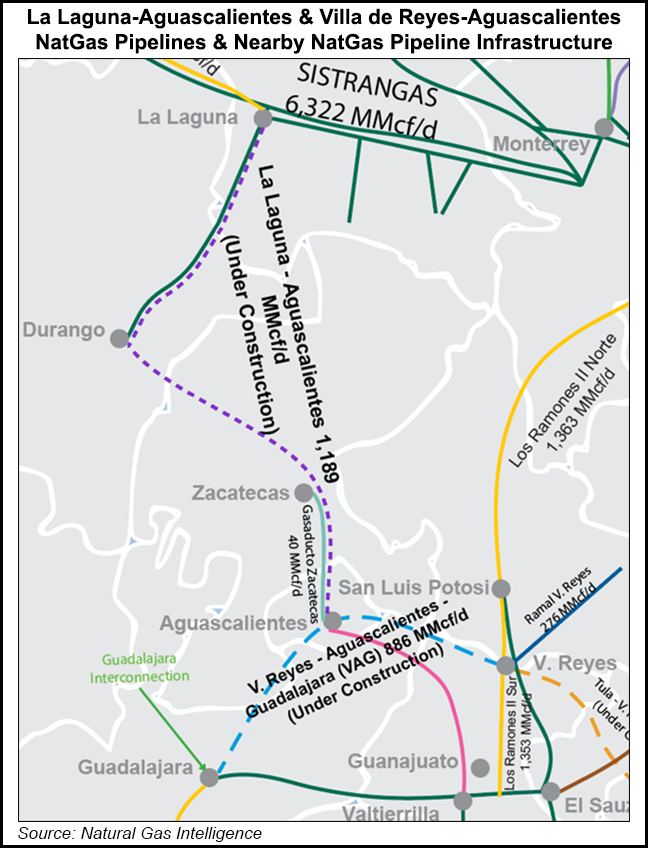Markets | NGI All News Access | NGI The Weekly Gas Market Report
Mexico’s Natural Gas Market “Making Progress,” Says BP Energy CEO
Mexico’s natural gas market continues to slowly advance towards an open and competitive business, the CEO of BP Energy Co. Orlando Alvarez said earlier this month at the U.S-Mexico Natural Gas Forum in San Antonio, TX.

Alvarez said that during the last year “some progress” in Mexico has been made on import permitting, daily and monthly reporting and invoicing, and access to real-time information.
He also highlighted the continued increase in U.S. exports of natural gas to Mexico. Pipeline natural gas exports to Mexico averaged 5.534 Bcf/d in August 2019, an 11.2% increase from the same month a year ago, according to energy ministry Sener. Imports accounted for 70% of Mexico’s total gas supply during the month, up from 68% a year ago.
Citing the fact that infrastructure is now in place for cross-border exports, Alvarez said that “last-mile pipelines within Mexico to bring gas to end users” were still lacking.
Indeed, Mexico boasts some 11 Bcf/d of pipeline import capacity – more than double current U.S. exports to Mexico – but a recent audit of Mexican utility Comisión Federal de Electricidad (CFE) by the Auditoría Superior de la Federación (ASF) found that CFE in 2018 only utilized 16.6% of its reserved capacity on its operational pipelines. The CFE is the anchor customer responsible for the massive pipeline buildout that has occurred in Mexico since 2012.
Alvarez said that the open season process, which began during the administration of Enrique Peña Nieto (2012-2018), remained a “work in progress.”
BP Energy is the natural gas marketing arm of BP plc, and operates in Mexico under the name BP Energía México.
BP Energía México was one of three winners in the inaugural auction, conducted in February 2017 by Mexico’s Centro Nacional de Control del Gas Natural (Cenagas), for natural gas import capacity into Mexico in the wake of the country’s 2013-2014 market-opening energy reform.
Through the auction, BP secured 200,000 MMBtu/d of capacity on the Net Mexico pipeline, which spans 120 miles from the Agua Dulce hub in Texas to the Mexico border near Rio Grande City.
But the new government of Andrés Manuel López Obrador has cancelled upstream oil and gas auctions and has remained silent on any new capacity release auctions via Cenagas.
Alvarez said the end of the pipeline standoff between developers and the CFE was good news for the market, in addition to the recent startup of the 2.6 Bcf/d cross-border marine pipeline. But he stressed that the upcoming completion of the so-called Wahalajara system will be an “inflection point” and “good for all stakeholders.”
The two pipelines that complete the system, La Laguna-Aguascalientes (1.2 Bcf/d) and Villa de Reyes-Aguascalientes-Guadalajara (0.9 Bcf/d), are crucial outlets for natural gas from West Texas to reach industry in Guadalajara, Mexico’s second largest city, and are expected to come online by the end of this year.
Manuel Bartlett, the head of CFE, has said these pipes are “the most important” in the system of pipelines in Mexico, as they will provide service to the centers of greatest consumption of natural gas in Mexico’s industrial heart.
Once in operation the pipelines will mean less reliance on liquified natural gas imports, enhanced liquidity and reliability in the natural gas system, and new price signals for further infrastructure development, Alvarez said.
As for the future, the BP Energy CEO said that the market still needed supply diversity, additional interconnects between the national pipeline system (Sistrangas) and CFE lines, electronic bulletin boards, and new services such as back-hauls, park and loans, and peaking services for power plants, so that a liquid, transparent market with numerous participants could take shape.
Alvarez, who also chairs the U.S. Natural Gas Supply Association, also sounded a warning that the natural gas industry in the United States faced numerous headwinds including environmental opposition to new pipelines and increasingly higher renewable energy standards in numerous states.
“The regulatory environment in the U.S. is very uncertain,” he said, adding that he believes natural gas has a role to play in providing the world more and cleaner energy, but that this message needs to be delivered to the American public.
“We have to remember it’s not a race to renewables, it’s a race to lower emissions,” he said.
© 2024 Natural Gas Intelligence. All rights reserved.
ISSN © 2577-9877 | ISSN © 2577-9966 | ISSN © 1532-1266 |
